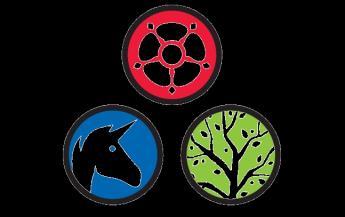

Rose Wood Oracy Progression
What does physical oracy look like?

To turn your body towards the speaker for an appropriate amount of time.
To speak to be heard clearly by others.
YEARS)
To consider position and posture when addressing an audience.
To experiment with adjusting tone, volume and pace for different audiences.
To use gesture to support meaning in play.
To speak audibly so they can be heard and understood.
YEARS)
To consider movement when addressing an audience.
To consider how tone, volume and pace influence meaning.
To use body language to show listening.
To experiment with adjusting tone, volume and pace.
To use gesture to support the delivery of ideas e.g. gesturing towards someone if referencing their idea.
To speak clearly and confidently in a range of contexts.
YEARS)
For body language to become increasingly natural.
To project their voice to a large audience.
To have a stage presence.
To adjust tone, volume and pace for a given purpose and audience.

Rose Wood Oracy Progression
What does linguistic oracy look like?

Linguistic
To use talk in play to practice new vocabulary.
To join phrases with words such as ‘if’, ‘because’ ‘so’ ‘could’ ‘but’.
To use talk in play to practice new vocabulary.
To join phrases with words such as ‘if’, ‘because’ ‘so’ ‘could’ ‘but’.
To use vocabulary specific to the topic at hand.
To take opportunities to try out new language.
To use conjunctions to organise and sequence ideas e g firstly, secondly, finally.
To use sentence stems to link to other’s ideas in group discussion (e.g. ‘I agree with… because …’ ‘Linking to …’).
To adapt how they speak in different situations according to audience.
To use sentence stems to signal when they are building on or challenging others’ ideas.
To use newly learnt vocabulary in an appropriate way.
To begin to use specialist vocabulary.
To be able to use specialist language to describe their own and others’ talk.
To begin to make precise language choices (e.g. describing a cake as ‘delectable’ instead of ‘nice’).
To carefully consider the words and phrasing they use to express their ideas and how this supports the purpose of talk.
To use specialist vocabulary when discussing a known topic.
To use an increasingly sophisticated range of sentence stems with accuracy.
To select specific vocabulary appropriate to the topic at hand.
To vary sentence structures and length for effect when speaking.
To be comfortable using idiom and expressions.
To use sophisticated vocabulary appropriate to the context and purpose of talk.

Rose Wood Oracy Progression
What does cognitive oracy look like?

Cognitive
YEARS)
To begin to understand how and why questions.
To use ‘and’ to link their ideas.
To describe events currently happening and what might happen next.
To ask questions.
To wonder about ideas.
To use ‘because’ to develop their ideas.
To describe events that have happened to them in detail.
To consider the merits of different viewpoints.
To offer reasons for opinions.
To disagree with someone else’s opinion politely.
To explain ideas and events in chronological order.
YEARS)
To offer opinions that aren’t their own.
To reflect on discussions and identify how to improve.
To be able to summarise a discussion.
To reach shared agreement in discussions.
To be able to give supporting evidence e.g. citing a text, a previous example or a historical event.
To ask probing questions.
To reflect on their own oracy skills and identify areas of strength and areas to improve.
To be able to draw upon knowledge of the world to support their own point of view and explore different perspectives.
To identify when a discussion is going off topic and to be able to bring it back on track.
YEARS)
To ask questions to find out more about a subject.
To build on others’ ideas in discussions.
To make connections between what has been said and their own and others’ experiences.
YEARS)
To construct a detailed argument or complex narrative.
To assess different viewpoints and present counter-arguments.
To spontaneously respond to increasingly complex questions, citing evidence where appropriate.
To acknowledge and explain changes of position.

Rose Wood Oracy Progression
What does social and emotional oracy look like?

Social & Emotional
To listen to others.
To take turns to speak with the support of an adult.
To listen attentively in a pair or small group.
To take turns to speak with a partner independently.
Listen carefully to others.
To participate in group discussions independently of an adult.
YEARS)
Listen actively, questioning and responding to others.
To adapt the content of their speech for a specific audience.
To speak with confidence in front of an audience.
YEARS)
To use more natural and subtle prompts for turn taking.
To develop an awareness of audience.
To consider the impact of their words on others when giving feedback.
Listening actively for extended periods of time.
To speak with flair and passion.
To encourage everyone to contribute.
To develop an awareness of audience, e.g. what might interest a certain group.
Confident delivery of short preprepared material.
YEARS)
To use humour effectively.
To be able to read a room or a group and take action accordingly e.g. if everyone looks disengaged, moving on, or if people look confused stopping to take questions.
To develop an awareness of group dynamics and invite those who haven’t spoken to contribute.


Rose Wood Oracy Curriculum
Oracy in Nursery


Physical Linguistic Cognitive Social & Emotional
To turn your body towards the speaker for an appropriate amount of time.
To speak to be heard clearly by others.
To use familiar words with confidence.
To use some taught vocabulary to describe.
To begin to understand how and why questions.
To use ‘and’ to link their ideas.
To describe events currently happening and what might happen next.

To listen to others.
To take turns to speak with the support of an adult.
Example outcomes:
Teaching ideas:
— Share a story (life story, fairy tale, etc) with a friend or familiar adult.
— Complete a puzzle or solve a problem as a group (without an adult’s help) using effective teamwork.
Speak about something they are interested in, for example a favourite toy or what they did at the weekend.
— Support students’ listening skills by playing sound identification games (for example: ‘who’s behind the barn door?’ with animal noises).
— Providing students with opportunities to give reasons for ideas, such as ‘Would you rather?’ activities.
— Use story time sessions to encourage children to use describing words for their favourite book characters.
— Support children to create their own characters and narratives. Use open-ended questions (‘I wonder what would happen if?’) to extend thinking and responses.
— Support children to use small world objects to retell stories using some familiar words ( for example – in Red Riding Hood: wolf, woods, grandma, blow, bricks, straw, wood, etc).
— Provide opportunities to explore volume during well-known rhymes and songs - sing it quieter, sing it louder, sing like a mouse, sing like a monster.


Rose Wood Oracy Curriculum
Oracy in Reception


Physical Linguistic Cognitive Social & Emotional
To use gesture to support meaning in play.
To speak audibly so they can be heard and understood.
To use talk in play to practice new vocabulary.
To join phrases with words such as ‘if’, ‘because’ ‘so’ ‘could’ ‘but’.
To ask questions.
To wonder about ideas.
To use ‘because’ to develop their ideas.
To describe events that have happened to them in detail.

To listen attentively in a pair or small group.
To take turns to speak with a partner independently.
Example outcomes:
Teaching ideas:
— Effective partner talk.
— A visit to supermarket or post office to practice speaking to an unfamiliar adult.
— Opportunities to speak for an extended period of time about something they are interested in, for example a favourite toy or what they did at the weekend.
Provide students with opportunities to take on different roles, ensuring they are equipped with the appropriate knowledge and vocabulary to do this successfully. E.g. a shopkeeper speaking to a customer might say ‘How can I help you today?’ ‘Yes, let me get that for you. One moment’. Give specific praise when they adopt a role and use language appropriately.
— Support students’ understanding of turn-taking in talk by using a physical object such as a toy to signify whose turn it is to speak.
— Support students’ understanding of listening through partner conversations. Break down what it means to listen and frequently return to this through praise. E.g. ‘Perfect partners sit calmly and face each other when they are listening’.
Introduce new language and sentence stems through call and repeat, ‘my turn, your turn’.
— Support students to develop an awareness of the volume of their voice through modelling and chances for them to practise speaking at different levels. E.g. ‘tell your partner what you had for breakfast in a whisper … now tell me your favourite colour in a playground voice!’


Rose Wood Oracy Curriculum
Oracy in Year 1


Physical Linguistic Cognitive Social & Emotional
To use body language to show listening.
To experiment with adjusting tone, volume and pace.
To use vocabulary specific to the topic at hand.
To take opportunities to try out new language.
To use conjunctions to organise and sequence ideas e.g. firstly, secondly, finally.
To use sentence stems to link to other’s ideas in group discussion (e.g. ‘I agree with… because …’ ‘Linking to…’).
To consider the merits of different viewpoints.
To offer reasons for opinions.
To disagree with someone else’s opinion politely.
To explain ideas and events in chronological order.
To ask a question when they haven’t understood.

Listen carefully to others.
To participate in group discussions independently of an adult.
Example outcomes:
To take part in a small group discussion without an adult.
To be filmed speaking and use this for reflection.
— To speak in front of a larger audience e.g. during an assembly.
Teaching ideas:
Introduce students to different protocols to scaffold turn-taking e.g. putting a thumb in when they want to speak, or taking turns passing talk around a circle.
— Use visual aids to support students’ awareness of talk e.g. using counters to represent contributions to a discussion or passing wool from speaker to speaker to show how contributions in a conversation should link to each other.
— As a teacher, explicitly model your own use of questions to clarify your understanding, e.g. ‘I didn’t understand that so I’m going to ask a question to help me. What did you mean by X?’
— Introduce students to the roles of the ‘builder’ and ‘challenger’. Equip students with sentence stems to fulfil each role.
— Draw students’ attention to the role that listening has in developing understanding. E.g. ‘Now that we have heard that, has anyone changed their mind?’


Rose Wood Oracy Curriculum
Oracy in Year 2


Physical Linguistic Cognitive Social & Emotional
To use gesture to support the delivery of ideas e.g. gesturing towards someone if referencing their idea.
To speak clearly and confidently in a range of contexts.
To adapt how they speak in different situations according to audience.
To use sentence stems to signal when they are building on or challenging others’ ideas.
To use newly learnt vocabulary in an appropriate way.
To ask questions to find out more about a subject.
To build on others’ ideas in discussions.
To make connections between what has been said and their own and others’ experiences.

To encourage everyone to contribute.
To develop an awareness of audience, e.g. what might interest a certain group.
Confident delivery of short preprepared material.
Example outcomes:
— Speak to unfamiliar people with real purpose e.g. asking questions to a museum curator or having a conversation with a visitor in the classroom.
— Participate in a short ‘show and tell’ session.
Teaching ideas:
— Introduce sentence stems with accompanying gestures to support meaning for both speaker and their audience. E.g. linking fingers together for ‘linking to’ and holding up one finger to emphasise their first point.
— Create different role play scenarios which enable students to practise speaking in different contexts e.g. having tea with the Queen, talking to a sibling, talking to a neighbour or a friend on the playground.
— Play games which encourage students to elaborate on their ideas, e.g. ‘tell me more’ or ‘just a minute’. Use hot-seating and question tennis to develop students’ questioning skills.
— Praise students who invite others into discussions and as a class develop ideas for how this can be done, e.g. saying their name, asking them a question, turning to them.


Rose Wood Oracy Curriculum
Oracy in Year 3


Physical Linguistic Cognitive Social & Emotional
To consider position and posture when addressing an audience.
To experiment with adjusting tone, volume and pace for different audiences.
To begin to use specialist vocabulary.
To be able to use specialist language to describe their own and others’ talk.
To begin to make precise language choices (e.g. describing a cake as ‘delectable’ instead of ‘nice’).
Example outcomes:

To offer opinions that aren’t their own.
To reflect on discussions and identify how to improve.
To be able to summarise a discussion.
To reach shared agreement in discussions.
Listen actively, questioning and responding to others.
To adapt the content of their speech for a specific audience.
To speak with confidence in front of an audience.
Take on an expert role e.g. to deliver a talk or speech as an astrologist or archaeologist. Become a storyteller for an authentic audience.
— Present to an audience of older or younger students. Chair a discussion.
— Hold a class meeting.
Teaching ideas:
— Expose students to a range of models for talk, e.g. by meeting an expert or watching a talk online. Unpick why each speaker is successful.
— Develop a shared language to describe talk in the classroom through creating a class set of ‘discussion guidelines’. These can be used as success criteria to support students to reflect on their discussions.
— Introduce ‘Talk Detectives’ to support students to reflect on their talk and raise students’ awareness of what makes good discussion.
Scaffold students’ summaries by allocating one student in a trio discussion the role of the ‘silent summariser’. While the other members of the trio discuss an idea, the silent summariser must remain quiet, listen and then feedback the main points at the end of the discussion.
— Play ‘articulate’ with specialist subject vocabulary.


Rose Wood Oracy Curriculum
Oracy in Year 4


Physical Linguistic Cognitive Social & Emotional
To consider movement when addressing an audience.
To consider how tone, volume and pace influence meaning.
To carefully consider the words and phrasing they use to express their ideas and how this supports the purpose of talk.
To use specialist vocabulary when discussing a known topic.
Example outcomes:

To be able to give supporting evidence e.g. citing a text, a previous example or a historical event.
To ask probing questions.
To reflect on their own oracy skills and identify areas of strength and areas to improve
To use talk for a specific purpose e.g. to persuade or to entertain.
— To speak in front of a larger audience of adults e.g. a group of eight.
— To collaboratively solve a problem.
To use more natural and subtle prompts for turn taking.
To develop an awareness of audience.
To consider the impact of their words on others when giving feedback.
— To speak with an unknown adult for a specific purpose, e.g. market research or ordering.
— To undertake peer teaching.
— To perform poetry by heart.
Teaching ideas:
— Introduce students to sentence stems to cite evidence and ask probing questions.
— Teach the conventions for different types of talk, e.g. in oral storytelling using similes, metaphors, time connectives, rich description and techniques to build suspense. In a persuasive pitch using a ‘hook’ to grab the audience’s attention, rhetorical devices such list of three and rhetorical questions.
— Create opportunities for students to reflect on their own oracy skills and those of their peers, and set targets for improvement.
— Set up discussions where each student has key information to bring to the discussion. E.g. each student has read a different historical source or piece of evidence and the group needs to decide the cause of the central event.
— When using trio discussions, allocate one member of the trio the role of questioner. Their sole responsibility during the trio discussion is to ask questions of the rest of the group.


Rose Wood Oracy Curriculum
Oracy in Year 5


Physical Linguistic Cognitive Social & Emotional
For body language to become increasingly natural.
To project their voice to a large audience.
To use an increasingly sophisticated range of sentence stems with accuracy.
To select specific vocabulary appropriate to the topic at hand.
To be able to draw upon knowledge of the world to support their own point of view and explore different perspectives.

Listening actively for extended periods of time.
To speak with flair and passion.
To identify when a discussion is going off topic and to be able to bring it back on track.
Example outcomes:
— Enter a debate competition.
— Create nature documentaries summarising learning on natural disasters with evidence supporting views. Create a podcast.
— Meet professionals e.g. a lawyer, an MP or councillor to ask questions about their job.
— Open a museum and share your expert knowledge with parents.
— Performance poetry.
— Stand up comedy.
Teaching ideas:
— Equip students with the language to describe when a discussion has gone off track and support them to identify when this has happened e.g. by looking at transcripts or video examples. Develop sentence stems for students to bring discussions back on track e.g. ‘That might be true, however what do you think about X?’ ‘It feels a bit like we are going off topic here. Let’s get back to X’.
— Teach strategies to be able to listen for an extended period of time, e.g. note-taking or drawing visuals.
— Use vocal warm ups and diaphragm breathing exercises to support voice projection. Some examples are in the book, This is a Voice.
Develop a bank of sentence stems which have a similar meaning to those students are already familiar with e.g. for agreement: ‘I agree and I would like to add …’ ‘I would like to echo what X said because …’ ‘I see it in a similar way to X because …’ ‘I have a similar opinion because ...’


Rose Wood Oracy Curriculum
Oracy in Year 6


Physical Linguistic Cognitive
To have a stage presence.
To adjust tone, volume and pace for a given purpose and audience.

Social & Emotional
Social & Emotional
To vary sentence structures and length for effect when speaking.
To be comfortable using idiom and expressions.
To use sophisticated vocabulary appropriate to the context and purpose of talk.
To construct a detailed argument or complex narrative.
To assess different viewpoints and present counter-arguments.
To spontaneously respond to increasingly complex questions, citing evidence where appropriate.
To acknowledge and explain changes of position.
Example outcomes:
Teaching ideas:
To use humour effectively.
To be able to read a room or a group and take action accordingly e.g. if everyone looks disengaged, moving on or changing topic, or if people look confused stopping to take questions.
To develop an awareness of group dynamics and invite those who haven’t spoken to contribute.
— Give a speech, that is persuasive, to an audience of peers and adults.
— Mentor or teach younger students. Lead an assembly presenting learning.
— Apply for school ‘jobs’ with a presentation.
— Act as a tour guides for prospective parents.
— Play games like ‘just a minute’ to practise fluency when talking about a given topic e.g. World War 2.
— Practise ‘power poses’ to explore physical aspects of speaking.
— Teach structures for building evidence-based arguments.
— Before students deliver presentational talk, create structured opportunities for students to reflect on what will engage their audience and the skills they need to be successful.
— Provide structured opportunities for students to summarise from group discussions.
